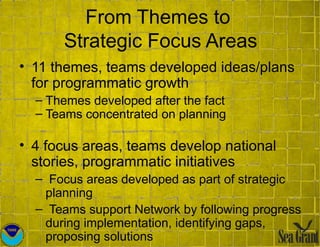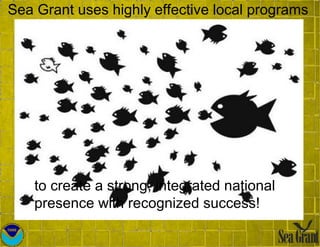The Evolution of Sea Grant as a National Program
- 1. The Evolution of Sea Grant as a National Program Plenary Session Dr. Leon M. Cammen Director, NOAA’s National Sea Grant College Program
- 2. Thank You
- 3. We are proud of our network and the way Sea Grant programs have come together to assist in the Gulf of Mexico. _____________________________ "There are so many databases and resources related to the oil spill that it is completely overwhelming. I don’t even know where to look (and I’m dealing with the topic every day), so I can’t even imagine your average non-scientist trying to find relevant information. For those of you interested in the RAPID and other Gulf projects going on, a good place to start is at gulfseagrant.org/oilspill/database. This site also has a good page with links to information about dispersants, seafood safety, human health, and research/monitoring updates.“ - Deep Sea News:
- 4. Sea Grant International • Welcome to our international visitors • History of working internationally • Levels of activity – Peer exchange – Capacity building – Institutional development
- 5. A National Vision for Sea Grant The whole is greater than the sum of its parts
- 6. National Vision • “One Sea Grant” • True university/federal partnership • Local regional and national priorities • Local and regional implementation • Strong impacts at all levels • National stories, measures and metrics that can used to garner support for Sea Grant
- 7. 32 local programs flying together as a true national Program
- 9. The Natural Order… Themes STRATEGIC FOCUS AREAS! Ad hoc White Papers
- 10. From Themes to Strategic Focus Areas • 11 themes, teams developed ideas/plans for programmatic growth – Themes developed after the fact – Teams concentrated on planning • 4 focus areas, teams develop national stories, programmatic initiatives – Focus areas developed as part of strategic planning – Teams support Network by following progress during implementation, identifying gaps, proposing solutions
- 11. Focus Team Roles and Responsibilities • Facilitate planning, implementation, synthesizing and reporting of SG activities and accomplishments – Reviewing annual reports and synthesizing results to tell the national story – Assessing progress in achieving goals and objectives and recommend mid-course corrections – Example: 1) Social Science Research not being accomplished, 2) Emerging success story on Sea Grant accomplishments in wind power siting
- 12. Focus Team Roles and Responsibilities • Identify new opportunities and directions for Sea Grant national and regional initiatives – Examples: 1) Proposing a new national investment in the application of climate sciences, 2) Developing a position paper on Sea Grant opportunities in offshore energy development
- 13. Focus Team Roles and Responsibilities • Catalyze cooperative efforts among SG and our partners – Examples: 1) Developing and implementing a partnership strategy with FEMA on community resiliency, 2) Identifying an opportunity for a leveraged RFP with the USACE that addresses wetlands restoration issues.
- 14. Focus Team Roles and Responsibilities • Provide a mechanism to further solidify Sea Grant’s local, regional and national identity – Examples: 1) Organizing and/or sponsoring or co-sponsoring national level conferences, symposia and other educational initiatives; 2) Developing a national media event to showcase Sea Grant contributions and success on a topic of interest.
- 15. Telling a National Story • National Performance Measures & Metrics • Impacts • National stories – Uses: NOAA leadership, DOC, OMB, Congress, State of Sea Grant Report (biennial report to the Congress), media (news releases, press events), NOAA, Climate Portal, web and program use & more • Critical step for positioning program as a national player
- 16. Performance Measures and Metrics = National Success Stories Annual Reporting Year (2/1/09 – 1/31/10) Sea Grant helped create or retain over 3,500 jobs and 650 businesses
- 17. Performance Measures and Metrics = National Success Stories Fishers, consumers and seafood industry stakeholders modified their practices using knowledge gained in fisheries sustainability, seafood safety, and the health benefits of seafood – Number of stakeholders modifying practices = 27,748 (2009 actual) – Number of fishers using new techniques = 366,687 (2009 actual) (SSSS focus area)
- 18. Performance Measures and Metrics = National Success Stories 435 (2009 actual) coastal communities adopted or implemented sustainable (economic and environmental) development practices and policies (e.g., land use planning, working‐ waterfronts, energy efficiency, climate change planning, smart growth measures, green infrastructure) as a result of Sea Grant activities (SCD focus area)
- 19. Performance Measures and Metrics = National Success Stories 186 (2009 actual) coastal communities restored degraded ecosystems as a result of Sea Grant activities (nearly 32,000 acres) (HCE focus area)
- 20. Performance Measures and Metrics = National Success Stories 160 (2009 actual) coastal communities adopted or implemented hazard resiliency practices to prepare for and respond to/minimize coastal hazardous events (HRCC focus area)
- 21. Performance Measures and Metrics = National Success Stories 1,560 resource managers used ecosystem based‐ approaches in the management of land, water, and living resources in ocean, coastal and Great Lakes areas as a result of Sea Grant activities
- 22. Performance Measures and Metrics = National Success Stories Sea Grant supported nearly 1,700 undergraduate and graduate students to develop a diverse, highly qualified workforce
- 23. Performance Measures and Metrics = National Success Stories Educators reached 380,875 K 12‐ students & 406 curricula were developed
- 24. Performance Measures and Metrics = National Success Stories Sea Grant published 212 Peer-Reviewed Journal Articles
- 25. Performance Measures and Metrics = National Success Stories • Sea Grant staff gave 4,283 public or professional presentations reaching 517,616 attendees • Certified 563 Clean Marinas • Certified 2,955 people in HACCP • Logged 167,477 volunteer hours
- 26. Vision: Sea Grant uses highly-effective, local programs to create a strong national presence with recognized success!
- 27. So … How long before we can see this national strategy is working?
- 28. Thank You
- 30. National Vision The total is greater than the sum of its parts
- 32. Sea Grant uses highly effective local programs to create a strong, integrated national presence with recognized success!
- 33. Partnerships: Coastal Integration Integrating NOAA’s Coastal Programs • OMB initiative • Sea Grant, Coastal Zone Management, Coastal Services Center, National Centers for Coastal Ocean Science • Collaboration & coordination
- 34. Partnerships: National Marine Fisheries Service (NMFS) Enhancing collaboration with NMFS • NMFS liaison • Sea Grant / NMFS Fellowships • Fisheries extension • Joint workshops
- 35. Partnerships: Office of Oceanic and Atmospheric Research (OAR) Extension agents in NOAA laboratories • Great Lakes Environmental Research Lab (GLERL) • Atlantic Oceanographic and Meteorological Lab (AOML) • National Severe Storms Lab (NSSL)
- 36. Regional Activities • Regional plans • Regional Competitions – Aquatic Invasive Species – Aquaculture – Regional Climate Mini-Grants • Aligned with National Ocean Policy, NOAA • $ to NOAA regions for joint activities
- 37. A 16-Year Evolution 1994 NRC report! Program Assessments! 2006 NRC report (PIE)!
- 38. Evolution of National Sea Grant Planning and Evaluation • 16-year history • 1994 NRC review – Program assessment system – Program strategic plans required • 2006 NRC review – Focused national plan and aligned state plans – Enhanced role of NOAA Program Officers • 2008 Planning, Implementation and Evaluation System adopted
Editor's Notes
- The process for developing the national performance measures began with the first focus team meeting the summer of 2008, where the teams developed a first draft of performance measures and outcomes. Drafts of the performance measures and outcomes were commented on by the network before finalizing the measures in the National Implementation Plan in February 2009. Programs then aligned their planning documents with the national strategic and implementation plans in the Fall 2009. Once all of the planning documents were reviewed by the review committee and then approved by the NSGCP Director, the NSGO went through every plan and looked at every program's performance measures and objectives to come up with a set of national performance measures that; (1) represented the network and (2) told a good national story. At the same time, the NSGO went through the metrics and decided to reduce the number of items programs were reporting on, making it easier for the programs. Before finalizing on a set of national performance measures and metrics, the NSGO sent a set of metrics and performance measures out to the network for comments in June 2010. Once network feedback was received, the NSGO made modifications to the performance measures/metrics and asked that the programs please use these for their annual reporting. The above processes are new to Sea Grant and the purpose of this survey is to evaluate the annual reporting system that has been developed to date. We appreciate your time and effort as you answer the following questions.





































